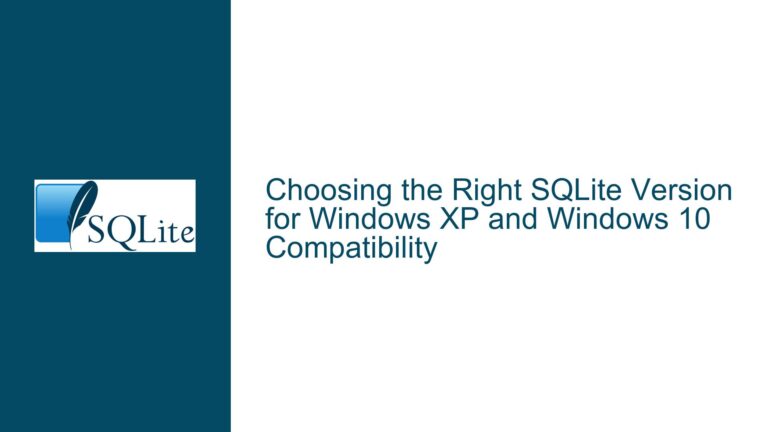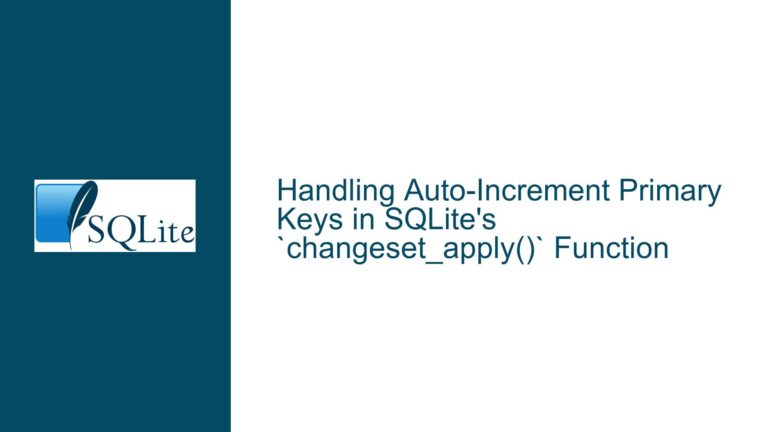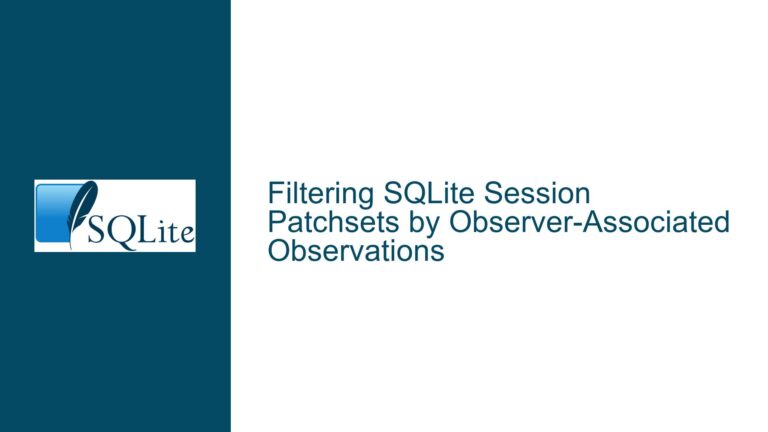SQLite3 -init File Ignores .exit/.quit Commands: Causes & Fixes
Interaction Between sqlite3 -init File and Exit Commands
Issue Overview: .exit/.quit in -init File Fails to Terminate CLI Session
When using the SQLite3 command-line interface (CLI) with the -init flag to specify an initialization file containing .exit or .quit commands, the CLI does not terminate as expected. Instead, it remains in interactive mode, presenting the sqlite> prompt. This occurs even if the initialization file explicitly includes commands like .exit 0 or .quit. However, using .exit 1 in the initialization file does cause the CLI to exit. This behavior is counterintuitive, as users typically expect .exit or .quit to terminate the session regardless of the exit code provided.
The problem manifests specifically when the CLI is invoked with a command like:
sqlite3 -init file.sql file.sqlite
If file.sql contains .exit 0, the CLI processes the file but does not exit. If the same file contains .exit 1, the CLI exits immediately. A workaround involves appending .quit to the command line:
sqlite3 -init file.sql file.sqlite .quit
This workaround succeeds because the .quit command is processed after the initialization file. The core issue revolves around how the CLI prioritizes input sources and handles exit codes from initialization files.
Possible Causes: Input Processing Order and Exit Code Handling
1. Input Source Processing Hierarchy
The SQLite3 CLI processes input sources in the following order:
- Commands specified directly on the command line after the database filename.
- The initialization file (if
-initis used). - Interactive input (the prompt).
This hierarchy is critical. The -init file is processed before interactive mode begins, but after any command-line SQL arguments. When .exit or .quit is placed in the -init file, the CLI executes it and then proceeds to the next input source, which is the interactive prompt (unless command-line SQL arguments exist). This explains why the CLI remains active after processing the -init file: the .exit in the -init file is executed, but the CLI then moves to the next input source (the prompt).
2. Exit Code Semantics in Initialization Files
The .exit command accepts an optional exit code. If the code is 0 (or omitted), the CLI interprets it as a successful termination of the current input source, not the entire CLI session. A non-zero exit code (e.g., .exit 1) signals an error, prompting the CLI to abort further processing. Thus, .exit 0 in the -init file terminates processing of the -init file but does not prevent the CLI from proceeding to the next input source (interactive mode). .exit 1, however, forces the CLI to exit entirely, as it treats non-zero exit codes as fatal errors.
3. Misuse of -init for Batch Script Execution
The -init flag is designed for persistent configuration (e.g., .mode column, .headers on) that should apply to all CLI sessions. It is not intended for one-off script execution. When users repurpose -init for batch processing, they encounter unexpected behavior because the CLI assumes the initialization file is for setup, not for scripted workflows. This design choice explains why .exit in the -init file does not terminate the session: the CLI expects to proceed to interactive mode after applying configurations.
Troubleshooting Steps, Solutions & Fixes
1. Use Command-Line SQL Arguments for Script Termination
Append .quit or .exit to the CLI command to ensure termination after processing the -init file:
sqlite3 -init file.sql file.sqlite .quit
Here, .quit is treated as a command-line SQL argument, which is processed after the -init file. This guarantees that the CLI exits after initializing the database.
2. Avoid -init for Batch Scripts; Use Pipes or Redirection
For scripted workflows, bypass -init and pipe the SQL script directly to the CLI:
cat file.sql | sqlite3 file.sqlite
This approach ensures the CLI processes file.sql as the primary input source, not an initialization file. After the script completes, the CLI exits automatically.
3. Modify Makefile Commands for Multi-Line Input
In Makefiles, use line continuation or heredoc syntax to pass SQL commands:
target:
sqlite3 file.sqlite <<EOF
CREATE TABLE t1 (id INTEGER);
.quit
EOF
For compatibility with FreeBSD’s make, use -j 1 to force single-shell execution:
make -j 1 target
4. Leverage Temporary Files for Complex Scripts
Generate a temporary SQL script and redirect it to the CLI:
file.sqlite: file.sql
sqlite3 $@ < $<
This method separates initialization from execution and avoids -init altogether.
5. Understand Exit Code Handling in Initialization Files
If you must use -init, structure the initialization file to exit on error conditions:
-- file.sql
CREATE TABLE IF NOT EXISTS config (key TEXT, value TEXT);
.exit 1 -- Force exit if a prior command fails
Non-zero exit codes in the -init file will abort the CLI session, while zero allows continuation.
6. Validate SQLite3 CLI Version-Specific Behavior
While the behavior described exists in SQLite 3.45.1 and newer, always verify with your specific version:
sqlite3 --version
Refer to the CLI documentation for input processing details.
7. Use GNU Make Features for Elegant Script Integration
Define multi-line variables in GNU Make to encapsulate SQL commands:
define SQL_SCRIPT
.mode table
.headers on
SELECT * FROM sqlite_master;
.endef
export SQL_SCRIPT
target:
@eval "$$SQL_SCRIPT" | sqlite3 file.sqlite
This approach avoids temporary files and keeps the Makefile self-contained.
By addressing input processing order, exit code semantics, and Makefile integration, users can resolve the .exit/.quit issue and streamline SQLite3 automation workflows.






